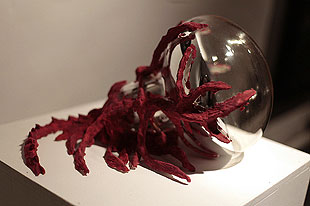Looking around at the Hard Science art exhibit in Chicago, you might be persuaded that someone with a canvas and paint can translate physics laws as effectively as someone with a calculator and a pencil.
Earlier this summer, Chicago’s Chuck Przybyl challenged a handful of artists to interpret the principles and practices of particle physics in their favored media. The result was Hard Science, which recently concluded at the Chicago Art Department.
“These ideas are cool – time, space, symmetry,” says Teppei Katori, a post-doctoral researcher from MIT who works with Fermilab. “The art doesn’t have to be correct, just science-inspired.”
Artist Edyta Stepien, who curated the exhibit with Przybyl, hoped to create something that would translate the highly conceptual realm of particle physics in a visually accessible way. She used pencil and ink to depict her take on the Higgs field and particle, which, she says, are fascinating in that so much of physics theory hangs on them though they haven’t been discovered.
The idea for the exhibit grew out of conversations between the artists and Katori.
“I didn’t understand the title of Teppei’s thesis. I couldn’t get through just listening to one sentence,” Przybyl says. “It was a reminder of how much knowledge is out there and how specialized these fields are. That inspired me.”
Katori gave Przybyl, artist Mark Salach and Stepien a tour of the Fermilab, a
high-energy particle physics laboratory outside of Chicago. During several extended gatherings, he also shared his knowledge of the particle world, including the Higgs boson search and the years of research that go into making a single measurement of a particle property.
Przybyl then invited artists to create works related to science concepts. They responded with pieces that address various subjects, like the machinery of particle detection and the act of data-taking.
“I quickly found that I could kind of understand what scientists were talking about, but there was always the one part that I just couldn’t get,” says Nat Soti, artist and Chicago Art Department co-founder. “That was the challenge – trying to understand it in order to make art about it.”
Once they did come to grips with the physics, the artists had the additional challenge of recasting those science concepts for viewers.
During the exhibit opening, Todd Frugia performed his piece Despite My Limitations. In it, he sat for four hours wearing noise-cancelling head phones while observing the gallery and its occupants in an attempt to view everything as a collection of particles. Attendees were invited to sit with him, don headphones, and also try to see the room, or Frugia himself, as made of the tiniest bits of matter.
“Scientists are in fact telling us that particles are what the world is made of,” he says. “What does it mean for someone to try to see it at this base level?”
The comedic potential of his performance is not lost on him: he fully expected some attendees – themselves particle collections – to get a chuckle out of his performance.
Katori, a scientist by profession, also contributed several art works to the exhibit. In “Eyes” of Particle Physicists, photomultiplier tubes – instruments that detect minuscule amounts of light and so “see” what the naked eye can’t – are shown with clay veins and nerves crawling out their backs.
“This device is an extension of your body,” Katori says. “It’s like an eyeball for the physicist.”
Though several artists expressed trepidation at what scientists might think about their takes on physics, Katori says the exhibit isn’t about getting it scientifically right.
“My hope is that, as people spend time with the pieces, the art will prompt them to investigate the science,” Przybyl says.
Visit the Hard Science site and its Flickr site.








